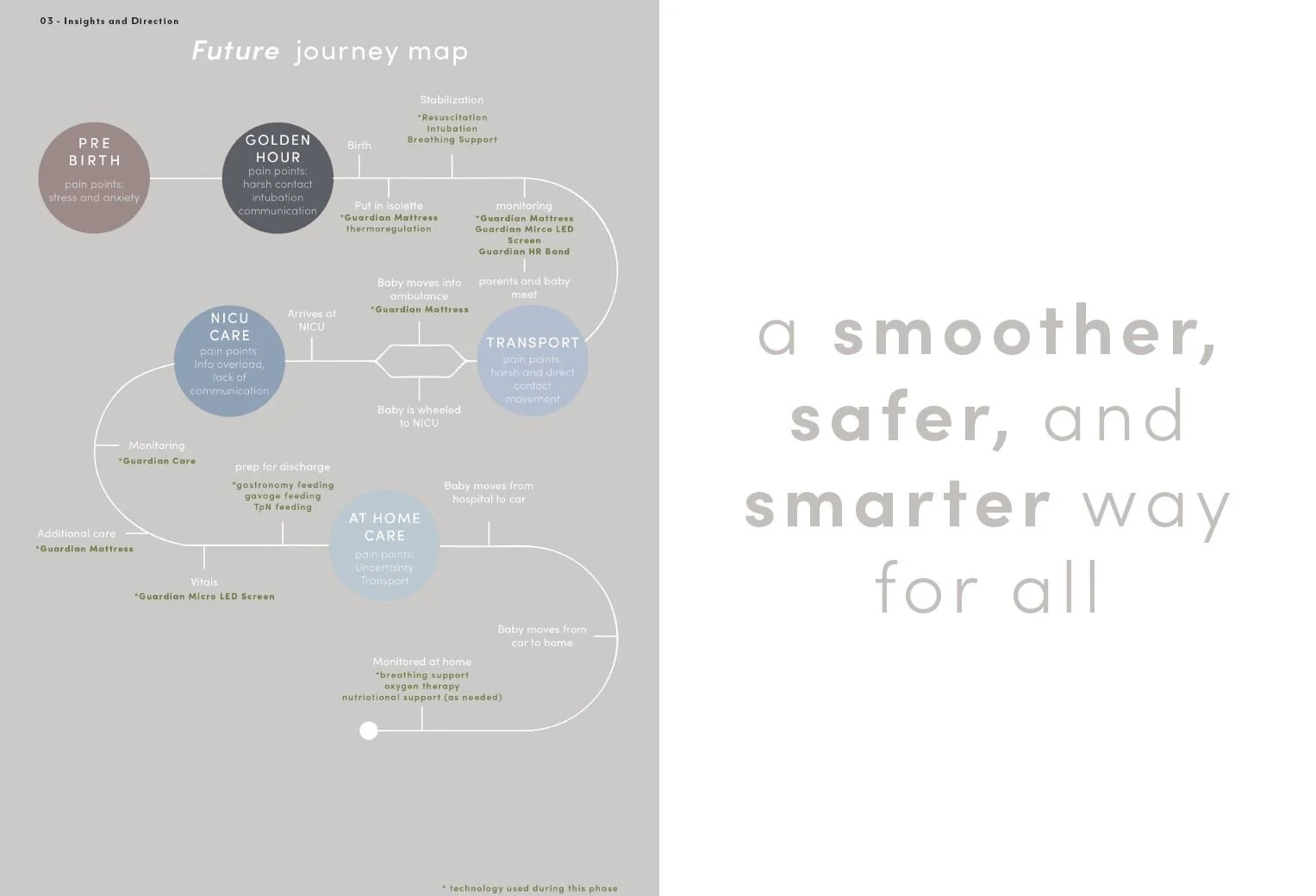The NICU (Neonatal Intensive Care Unit ) is designed to provide extremely specialized care for premature babies. Their critical state makes them highly dependent on neonatal medical technology. A stable environment essential for their well being , and current technology is underdeveloped and underfunded. This is why it is our goal to make the NICU experience smoother and smarter for staff, parents , and especially babies.
Over the course of 10 weeks, we identified pain points within the NICU experience and developed solutions that resolve problems in communication, monitoring, and stabilization. We were inspired by Layer Design’s clean and straightforward design language and graphic content to best communicate our solutions.
RESEARCH
USER JOURNEY MAPS
One of the most important parts of our research was developing an understanding of the NICU process in its entirety, focusing on the hospital staff, parents, and of course the baby. We created a timeline for each, highlighting areas along the journey that caused the most pain points, golden hour, transportation, and at home care.
From our in-depth research and journey maps, we highlighted the four main pain point areas, using them as the basis for our design solutions
The Golden Hour is a term used to describe the crucial hour after delivery. This hour is critical for gathering vitals and stabilizing the newborn and may dictate what the baby’s experience in the NICU will be like. This is the time when important medical interventions like intubation and resuscitation are executed. Even small decisions make big waves during the Golden Hour.
Transporting a premature infant may be necessary in some cases where a hospital does not have a NICU or be able to provide the care required in their NICU. Moving a baby in such critical conditions is not ideal, and many of the environmental factors in the processes do not help the situation. Multiple nurses are required to lift and move the baby from its stationary incubator to a transport incubator, which is then wheeled from the hospital to the ambulance, lifted into the ambulance, and secured before travel. Our research showed that moving the transport incubator within the hospital was actually more problematic, exposing the baby to larger and more frequent vibrations and sounds than in a transport ambulance.
The Technology used in the NICU is complicated and diverse, sometimes causing problems due to the difficult-to-interpret information on the monitors and their inability to communicate with other machines. The reason for this is that hospitals only update equipment when necessary and will often pick the cheapest, most effective machine without regards to the company name, leading to a disconnected NICU. Additionally, all of these monitors and machines use multiple wires, which can become tangled in what is colloquially known in hospitals as “spaghetti,” and can get in the way of skin-to-skin contact with the mother during kangaroo care. Because of this, doctors and nurses desire a more streamlined NICU in which information is easier to process and the wires from the machinery do not inhibit their ability to care for the baby.
It can be a stressful time for doctors and parents when it is time to take the baby home. Doctors may have concerns about how ready and equipped a parent is to take care of their baby since it’s the first time the parents will be taking care of their baby without any guidance or assistance. When a premature baby is ready to leave the NICU, specialized padding and head supports must be used to support the baby’s neck. Some premature babies may go home with some additional equipment for nutritional or breathing support which may further complicate the parents’ care routine.
OUR SOLUTION: THE GUARDIAN
The Guardian is an ecosystem of products consisting of technology that betters the NICU environment for the baby, the parents, and the staff. The Guardian products consist of a smart mattress, heartbeat bracelet, adaptable micro LED screen, and non-contact monitoring. Our solutions communicate with each other to ensure the health and safety of the baby. The monitor can recognize when vitals are not ideal and adjust the ecosystem to fit the baby’s needs; for instance, if the monitor senses that the baby’s temperature is too low it will tell the mattress to increase the temperature.
The Mattress
The Monitor
Detachable device that can be used for wireless monitoring during kangaroo care
When a baby has to move outside of the incubator, they can still be monitored by the detachable component of The Guardian monitor. The removable device can be worn on the finger of the mother and placed in contact with the back of the baby. No adhesives would need to be used, preserving the baby’s skin.
Monitoring between devices in the ecosystem
The Screen
Each vital can expand to show a more in-depth set of data from the monitoring system. There is also an electronic tint film that is applied to the incubator, which allows the doctors and nurses to adjust the amount of light the baby is exposed to at any given moment. Both the display and the electronic tint are flexible films that can be retrofitted to existing incubator.
Creating the ideal NICU experience with through the Guardian
The ideal NICU experience should be able to provide fast and easy communication with the parent in a clear and confident way. User-friendly technology should be used for both parents and doctors to create a stress-free environment for the baby. The neonate should also be as comfortable as possible at all times, from routine check-ups to diaper changes. The ideal NICU experience would allow the baby to move freely and safely.


















